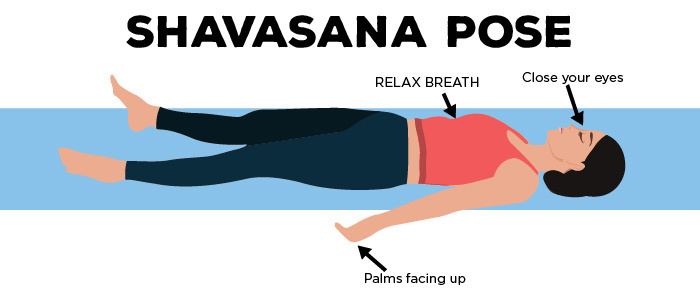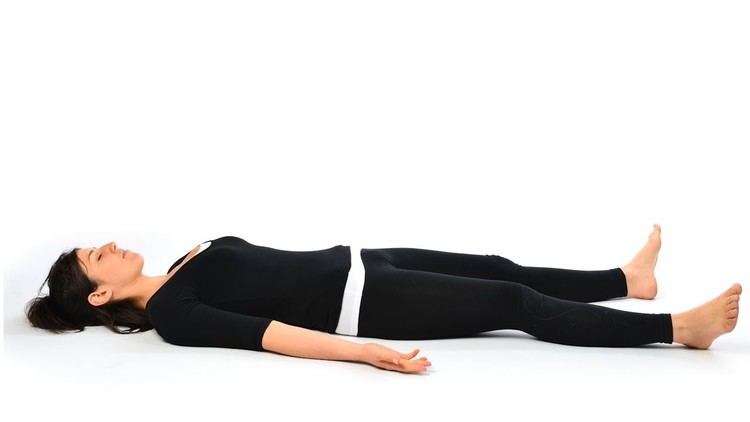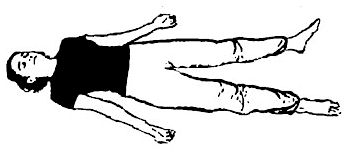Pose type Restorative | Also known as Savasana, Corpse pose | |
Note Consult a doctor before beginning an exercise regime Similar Bhujangasana, Bālāsana, Sarvangasana, Tadasana, Adho mukha śv | ||
Shavasana, Savasana (shah-VAH-sah-nah; (/ˌʃəˈvaˌsəˌnə/); Sanskrit: शवासन; IAST: śavāsana), or Corpse Pose is an asana. Shavasana is a pose usually done at the end of a yoga practice in which practitioners lay flat on their backs with the heels spread as wide as the yoga mat and the arms at the sides of the body, palms facing upward.
Contents

Etymology

The name comes from the Sanskrit words Shava (शव, Śava) meaning "corpse" and Asana (आसन, Āsana) meaning "posture" or "seat". Although it is difficult to find information on the history of shavasana, the Hatha Yoga Pradipika contains the earliest mention of this pose. The Hatha Yoga Pradipika states “lying full length on the back like a corpse is called Savasana. With this asana, tiredness caused by other asanas is eliminated; it also promotes calmness of the mind.”
Description

Yoga is a system of mental and physical training. It consists of postures, breathing exercises, and meditations that give knowledge of reality to many practitioners. Shavasana and other sitting postures maintain the balance between relaxation and meditation (two key components of yoga) by their equal input of physical stimuli.
According to many yoga students and instructors, Shavasana is said to be the most important part of a yoga practice. This pose is achieved by lying on the back with the arms legs spread as wide as the yoga mat and arms relaxed to the side. The eyes are closed and the breath is deep with the use deergha (long) pranayama. The whole body is relaxed on the floor with an awareness of the chest and abdomen rising and falling with each breath. During Shavasana, all parts of the body are scanned for muscular tension of any kind. Any muscular tension the body finds is consciously released as it is found. All control of the breath, the mind, and the body is then released for the duration of the asana, typically 20–30 minutes.

The asana is released by slowly deepening the breath, flexing the fingers and toes, reaching the arms above the head, stretching the whole body, and exhaling while bringing the knees to the chest and rolling over to the side in a fetal position.
Benefits

Shavasana is intended to rejuvenate the body, mind, and spirit. In Shavasana, practitioners’ breath deepens, and the stress of the day is released. The yogi forgets all other thoughts and surrenders any psychological effort. While in Shavasana, yogis slip into blissful neutrality and reflect on the practice.
Relaxation
After the exertions of the practice, Shavasana allows the body a chance to regroup and reset itself. After a balanced practice, the entire body will be stretched, contracted, twisted and inverted. Therefore, even the deepest muscles will have the opportunity to let go and shed their regular habits, if only for a few minutes. Furthermore, the physiological benefits of deep relaxation can be numerous (as seen below). However, none of the following have been scientifically proven:
Integration
A complete yoga practice will furnish the nervous system with a host of new neuromuscular information. Shavasana gives the nervous system a chance to integrate that into a brief pause before it is forced to deal with the usual stresses of daily life once again.
Inner focus
After so much time being bound to the actions of the body, the practitioner's awareness is hopefully turned inwards and purified of sensory distraction. Shavasana then becomes the beginning of deeper, meditative yogic practices. In a state of sensory withdrawal, it becomes easier to be aware of the breath and the state of the mind itself. Though not the best position for prolonged meditative contemplation, Shavasana dulls the mind enough that the discernment necessary to achieve deeper meditative states becomes more difficult. This reclination can be a successful introductory practice for those practitioners who are not yet ready for formal meditation.
Completion
The yoga practice is a form of ritual. Regardless of the style of yoga, most classes follow the same Shavasana pattern. It begins with a short opening period where the practitioner gathers him or herself up, turning inwards away from the mundane world and setting an intention for the practice. The practice itself follows this setting of an intention. The integration phase—the ending point of a practice—allows the effects of the practice to take hold and penetrate deep into the self; Shavasana is the primary vehicle of this process.
Complications
Comfort is essential in the asana; the slightest point of discomfort can be endlessly distracting. Shavasana is a good way to reduce stress and tension. On the other hand, yoga-nidra ("yogic sleep") meditation is often practiced in a lying position. Drowsiness or restlessness of the mind while in Shavasana may be counteracted by increasing the rate and depth of breathing. While in Shavasana, it is important to be in a neutral position. Although Shavasana ends a practice in relaxation, some practitioners might not be able to relax and let go in this position, which is completely normal. If this is the case, it is recommended to practice the pose with the feet on the floor and the knees bent, hip-distance apart.
